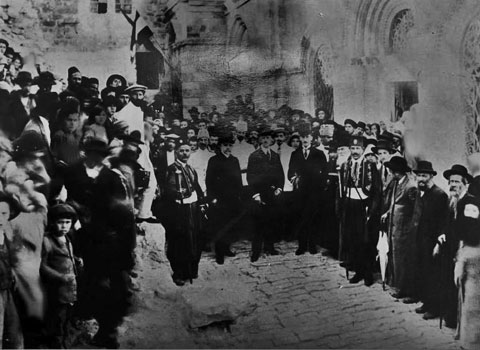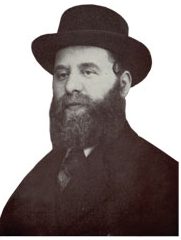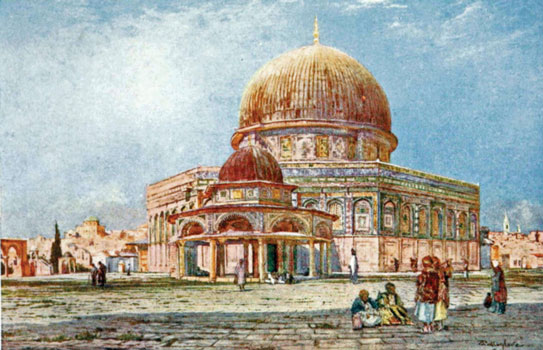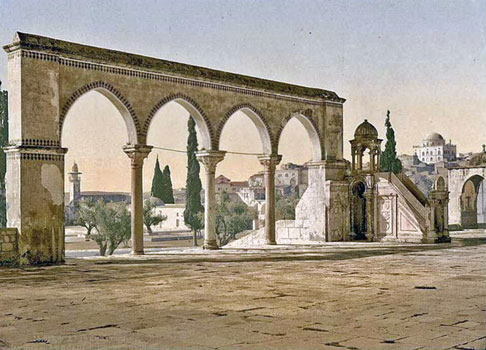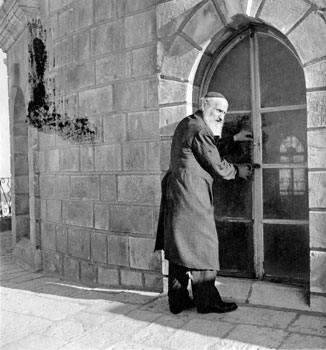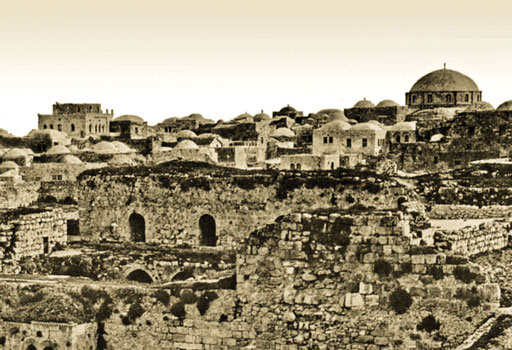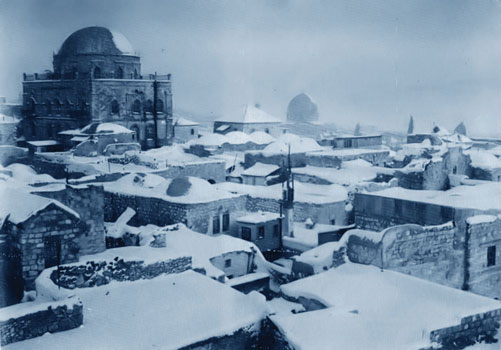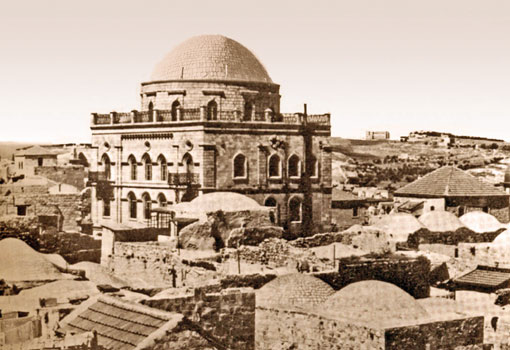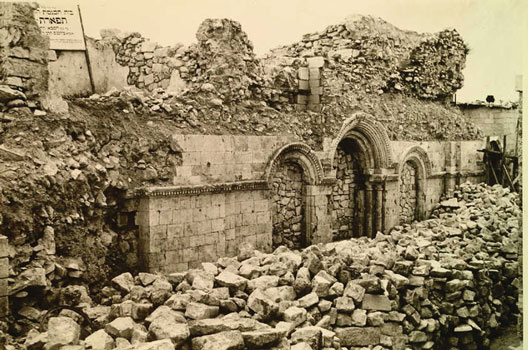The Kaiser Goes to Synagogue
For the Middle East, 1869 was a critical year: after much planning and unstinting effort, the digging of the Suez Canal was finally completed. At last a shorter route connected Europe and the Far East. Among the world leaders attending the canal’s dedication ceremony was Franz Joseph, emperor of Austria-Hungary. When the kaiser decided to visit Jerusalem as well, roads were paved and flags were hung amid raised Ottoman hopes of stronger ties between the world’s two largest empires.
Throughout his sixty-eight-year reign – the third-longest in Europe – emperor Franz Joseph I was beloved by his many subject nations. A great liberal, the kaiser raised Hungary’s standing to that of Austria and made his capital, Vienna, the center of European high culture
Franz Joseph walked the ancient streets of the Holy City, paying his respects to all its major sites and even strolling through the Jewish Quarter. The kaiser’s appearance in the quarter was described at length in the Hebrew journal Ha-havatzelet ’s round-up of the Hebrew year just ended, 5630. Gushed editor Israel Dov Frumkin:
On 6 Kislev 5630 (November 10, 1869), the country was lit up by the splendor of His Glorious Majesty, His Honor, the mighty emperor, the merciful Franz Joseph I. […] After touring the site of the Temple, the worthy emperor paid [the Jews] the honor […] of heading toward Jews’ Street to visit the Jewish sights. He graced the great Sephardic synagogue with his illustrious presence. (Ha-havatzelet, 12 Tishrei 5631/October 7, 1870)
Franz Joseph and his entourage in the courtyard of the Ruzhyn synagogue in Jerusalem. Nisan Beck, marked by his long, white beard, appears at far left. This photo affords a rare glimpse of Beck, who generally refused to be photographed, citing the biblical injunction against graven images
Aside from Mayer Rothschild Hospital, the kaiser visited the Lemel School (the first in Jerusalem to teach secular subjects, and the first to provide vocational training) and the Tiferet Israel (“Glory of Israel”) Synagogue, both established by his Austro-Hungarian subjects. The synagogue was built between 1857 and 1872 by Jerusalem’s Vohlin Hasidic community (so called because the majority of its members originated in the Ukrainian region of Vohlin), with funds from the Ruzhyn and Sadigor Hasidic dynasties in Russia and Austria, and was named after Rabbi Israel Friedman of Ruzhyn. The Hasidic master purportedly instigated its construction after his disciple Nisan Beck, who had emigrated to Ottoman Palestine, returned to visit his mentor in Sadigor. Beck informed the rabbi that Czar Nicholas I of Russia was about to purchase land close to the “Wailing Wall” and build a church and monastery there. Beck came back to Jerusalem with a mission – to buy the site from its Arab owners, whatever the cost, before the czar made his move. Rabbi Israel raised the capital to acquire the property, despite its exorbitant price, and built a synagogue there.
Coverage of the kaiser’s donation to Tiferet Israel, Ha-havatzelet, 12 Tishrei 5631/October 7, 1870
A famous Jerusalem anecdote recounts that Tiferet Israel was almost completed before the kaiser’s visit, apart from the dome on its roof. Construction of this last, inessential feature had been delayed, as the money had run out. Wondering at the missing dome, Franz Joseph was informed by the quick-witted Beck (who also served as the synagogue beadle) that Tiferet Israel had tipped its hat in his honor. Amused by Beck’s reply, Franz Joseph granted him the funds to complete the structure.
Which Benefactor?
But is the story true? Was the dome really missing when the kaiser arrived, and did he actually pay for it? One photo of the Jewish Quarter from the 1860s shows only the drum of a dome atop Tiferet Israel. Announcing the acquisition of funding for its completion, Isaiah Halevi Horowitz reported in Ha-havatzelet how starkly lacking the edifice had been:
The money ran out some two years ago, just when the dome was to be put in place, and everyone passing the imposing structure was disturbed to see it thus: a fine legacy in full glory, but without cover or protection from shower or rain. (22 Elul 5631/September 8, 1871)
So apparently the building was indeed roofless during Franz Joseph’s visit. But did he finance the dome? In Ha-havazelet’s original account of the emperor’s tour, Frumkin emphasized Nisan Beck’s attempts to interest the kaiser in the synagogue’s condition:
[The kaiser] went gladly to the synagogue named Tiferet Israel, which stands proud thanks to the efforts of […] Nisan Beck, […] and looked favorably on the beauty and power of its dimensions. And as proof of his appreciation for the agent, he stretched out his illustrious hand and donated a thousand francs to the synagogue, to show that his generosity also extended to Jews. (12 Tishrei 5631/October 7, 1870)
The emperor, then, did donate substantially to the building’s completion. Yet there’s no indication here that the money was earmarked for the dome, nor is there any reference to Beck’s comment about the synagogue tipping its hat to Franz Joseph. Frumkin might have been unaware of those details, but as he was Beck’s close friend and former brother-in-law, that seems unlikely.
Horowitz’s article does quote the “king of Hungary” as saying, “The glory of this sanctuary will be great,” but fails to mention Beck’s quip – or the kaiser’s donation for the dome. In fact, Horowitz credits a different benefactor:
And now, to the delight of lovers of Zion and all who take pride in its glory, we can announce that, thanks to the interest of the holy master, our famed teacher Rabbi Abraham Jacob of Sadigur, long may he live, who has kindly intervened on behalf of this wonderful building and sent a dedicated person, to be supported by […] our teacher Rabbi Nisan Beck, so that the two of them can ensure its completion, which requires another five thousand silver rubles […] to cover and provide the dome of the roof, stone flooring, etc. (22 Elul 5631/September 8, 1871)
Rabbi Abraham Jacob Friedman of Sadigur, the man who “capped” Tiferet Israel. The synagogue was named in memory of his father, Rabbi Israel Friedman of Ruzhyn, its original funder
So it was Rabbi Israel of Ruzhyn’s son, Rabbi Abraham Jacob of Sadigur, who financed the completion of the dome.
What, then, was the source of the tale about the emperor? It’s hard to pinpoint, but the story was definitely born in the 20th century, at least thirty years after the fact. The proof is an 1898 article in Ha-tzefira, a Zionist journal published in Warsaw and Berlin. Recording his impressions of the Holy Land, visiting journalist Abraham Ludvipol heard the following at Tiferet Israel:
When the work had reached the ceiling, the leaders of the community had no means left to complete the building, and it stood without a dome until 5632 (1872). Then Rabbi Israel’s son, having succeeded him in his righteous position in Sadigur, sent a special messenger to Jerusalem, enjoining him to complete the synagogue building at his expense. (Ha-tzefira, 9 Nisan 5658/ April 1, 1898)
So even at the end of the 19th century, tourists in Jerusalem were not yet privy to the legend of the emperor Franz Joseph and the cap.
Tiferet Israel was finally finished and dedicated on 15 Av 5632 (August 19, 1872). Ha-havatzelet devoted two pages to the occasion, noting the building’s ample dimensions and aesthetics, but particularly its roof:
A large and lofty dome, resting on the building’s four thick, high walls, its contours surrounded by twelve windows […] and a delightfully ornate gallery beneath, with a cast-iron balustrade around it. (19 Av 5632/August 23, 1872)
The Perushim (“Separatists,” so called to distinguish themselves from Jerusalem’s Hasidic community) couldn’t ignore the Hasidic prayer center’s completion so close to their own Hurva Synagogue, but their Ha-Levanon journal reported the event only a month later, in biting tones:
Two weeks have elapsed since the house of God known as Tiferet Israel, belonging to our Hasidic brethren in the Vohlin commune, was dedicated amid much joy and celebration. The lofty heights of the synagogue are indeed a wonder both inside and out, and it is modeled on the holy Perushim community’s great Beth Jacob Synagogue […], only smaller and lower. (22 Elul 5632/September 25, 1872)
Find the difference. John Fulleylove’s 1895 painting of the Temple Mount (published in The Holy Land by John Kelman, 1902) shows Tiferet Israel in the background at far left, complete with its green roof
Green with Envy
The Perushim also dwelled on the synagogue’s dome, particularly its exceptional height and color:
Freshly painted in a shade of green, its dome overlooks the entire city, and anyone seeing it can tell that this is our Vohlin Hasidic brethren’s house of prayer. How wonderful are God’s works! The Ishmaelites [Muslims] are grief-stricken, whistling and gritting their teeth […], their hatred tempered with envy. How their anger burned when they saw the green of the synagogue’s dome, for green is a holy color for Muslims. Twenty years ago, if a Jew dressed in green passed them in the street, they’d strike him, wound him, drag him away, and tear the coat off his back. Now they see an Israelite house of prayer rising so gloriously, with the holy color upon it, and all they can do is grind their teeth until they fall from their jaws. (ibid.)
Tribute to a Hasidic master builder. Rabbi Israel Friedman of Ruzhyn, who bought the land on which Tiferet Israel was built and funded most of the synagogue’s construction, presided over a Hasidic court famed for its regal pomp and splendor. Tiferet Israel’s magnificent interior, postcard published by Wilhelm Gross of Jaffa and Jerusalem, 1901
The Ottoman Empire strictly enforced the ban on green attire among non-Muslims, as Jewish travelers from the 16th to 18th centuries testified. In the 17th century, Rabbi Moses Porayat warned Jewish tourists:
One must be careful not to take any green clothing, even if there’s a single green thread in the entire garment, and the same applies to stockings. Don’t bring any such thing to the Holy Land; anyone wearing green is in grave danger. Sometimes the edge of a prayer shawl decoration might be green; that too must be altered, for green is forbidden to Jews throughout the land of Turkey and in Jerusalem. (“Journeys of R. Moses Porayat of Prague,” in Abraham Ya’ari, Journeys to the Land of Israel, p. 277 [Hebrew])
The outrage provoked by Tiferet Israel’s green dome still comes across in an article published by Eliezer Ben Yehuda in his Ha-tzvi weekly fully fifteen years later. Greeting Baron Edmond de Rothschild and his wife, Adelaide, on their visit to Ottoman Palestine, Ben Yehuda listed their itinerary, adding:
We’ve heard that when the baron passed the Tiferet Israel Synagogue and saw that the dome above it was painted green (knowing as he did that Muslims take a dim view of non-Muslims’ using their holy color), he sent to ask the beadle, Rabbi Reb Nisim [sic] Beck, to paint the dome a different color in order to appease the natives. It will be done, and all the Muslims are blessing the baron for it. (19 Iyar 5647/May 13, 1887)
Ben Yehuda’s description indicates that the dome remained green for years, with the Ottoman authorities doing nothing about it, presumably because of their weak standing in Jerusalem. The structure was repainted only at a Jewish baron’s initiative.
Ben Yehuda would seem to be a reliable source. Yet in Frenchman Pierre Loti’s illustrated travelogue, published in English in 1895, the synagogue’s dome is green. So maybe Baron Rothschild’s request was ignored, or – this being the Middle East – it took years to be fulfilled. Or perhaps the illustration in Loti’s book predated the dome’s makeover. Either way, sketches from the early 20th century depict the cupola in white or gray.
Tiferet Israel and its dome overlooked the Jewish Quarter for some eighty years. In the throes of Israel’s War of Independence, Hagana fighters used the synagogue roof as a lookout point, and bitter battles were fought within the building. Defended by residents of the Old City as well as soldiers – including some of the youngest participants (and casualties) in the struggle to maintain a Jewish presence in the quarter – Tiferet Israel became a strategic symbol of defiance. It watched helplessly as the quarter’s Jewish inhabitants were driven from their homes on 19 Iyar, May 28, 1948. The next day, Jordanian forces blew up the entire synagogue, leaving nothing of the dome or its adventures. But those who’d been forced to abandon it never stopped dreaming of one day gazing down at Jerusalem yet again, from the soaring dome of a rebuilt Tiferet Israel.
In December 2012, sixty-four years later, plans to restore the “Glory of Israel” were approved, finally placing that dream within reach. Excavations have revealed remnants of a much earlier destruction, by the Romans in the first century, and reconstruction recently commenced. The question is, what color will the dome be this time?


